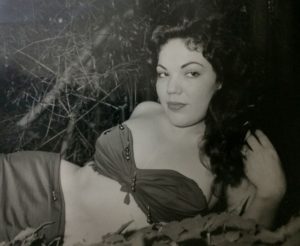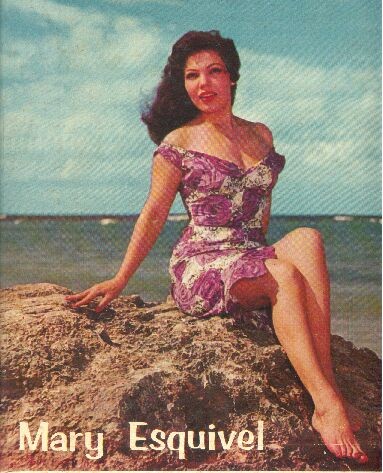Maria Esquivel, also known artistically as Mary Esquivel (Born in Quemado de Güines, Las Villas, Cuba 1934 was an actress of cinema and television, dancer, singer, rumbera and Mexican vedette of origin Cuban.
In the early 1940s she moved with her family to Havana. From a very young age she began to declaim in school, besides writing her own poems. At the age of 14 she made her debut as a proclaimer, and the following year she left for Mexico to try her luck, trying to make her way to the movies.
He participates in a contest organized by the filmmaker Juan Orol in Cuba to find his new film muse (after his divorce from the Cuban rumba María Antonieta Pons). However, Orol ends up choosing as the new star of his films the also rumbera Rosa Carmina. Esquivel departs for a tour of Central America before returning to Cuba. He married in 1953, eventually divorced and returned to acting without much success. In 1955 he meets again with Juan Orol, who was in Cuba precisely to make a film. Esquivel marries Orol and they leave for Mexico.
Esquivel begins to appear in films under the direction of Orol. It debuts in a small roll in the tape History of an unfaithful husband (1956), carried out by Rosa Carmina. A year later, Orol gives him his first starring role in the film ‘I Hate You and I Love You’. In 1958 he made his first film without the baton of Orol, Los salvajes, a film directed by Rafael Baledón and in which he has the opportunity to alternate with Pedro Armendariz. The film competed at the Cannes Film Festival that year, where, however, it was shattered by criticism.
In that same year, it films under the baton of Orol the tape A lighthouse of the window, filmed in Cuba and that happened in the cinemas without pity nor glory. Under the baton of Rogelio González also films Woman in condominio, where alternates with the famous composer Agustín Lara. In that same year, Esquivel stars in one of his most remembered films, and probably one of the most famous films by Juan Orol: Zonga, the devilish angel. Orol decided to burn his ships in a super production, making use, for the first time, of the color and cinemascope. The plot had its origin in a very successful comic: Tabu !, by Guillermo de la Parra, later known in the 1970’s as Rarotonga. This was to the benefit of the film. Finally, the “director of the crowds,” as Orol called himself, returned to the box office after so many failures. Mary Esquivel began to shine with a certain intensity.
In 1959 Orol and Esquivel put their eyes on Spain. The director Manuel Mur Oti, almost an institution in Spain, was the accomplice chosen for this new adventure that was called Duelo en la Cañada, a period drama, where Orol only co-produced. Here, Esquivel, was an innocent singer of inn that by chances of the script was involved in a crime not committed. Back in Mexico, the actress acts without the baton of Orol in the film Los Santos Reyes, where she alternates with Antonio Aguilar, Antonio Badú and Sara García, among others. In 1960, the film couple returned to Cuba, where they filmed Tahimí, the fisherman’s daughter. As fellow cast members, Orol hired Rubén Rojo and Armando Calvo. In 1961 the actress shared credits with Germán Valdés “Tin Tán” in the film El duende y yo.
https://youtu.be/BOoObE42K7Y
Esquivel works with Orol on four more tapes. In 1964 also performs a performance in the Mexican telenovela El Crisol. So they continued until in 1964 they decided to divorce their affections and interests and each one to follow its way. Mary Esquivel withdrew from the spotlights and celluloid. The sexagenarian Orol, on the other hand, was arrested for a fourth muse, Dinorah Judith, the star of the twilight, who, following the path of his predecessors, also became wife, the fifth and last wife, of the controversial director.
After filming her last film “The Crime of the Estate” (1964), Mary Esquivel retired from the show business and for many years her whereabouts and activities were unknown. Mary Esquivel Died in Mexico, June 30, 2007.
MARY ESQUIVEL, ARTISTA DEL CINE Y TV MEXICANO, CANTANTE, BAILARINA.
María Esquivel, conocida artísticamente también como Mary Esquivel (Quemado de Güines, Las Villas, Cuba 1934 – Ciudad de México, México 30 de junio de 2007), fue una actriz de cine y televisión, bailarina, cantante, rumbera y vedette mexicana de origen cubano.
María Esquivel nació en Quemado de Güines, Las Villas, en 1934. A principios de la década de 1940 se mudó con su familia para La Habana. Desde muy pequeña empezó a declamar en la escuela, además escribía sus propios poemas. A los 14 años debutó como declamadora profesional, y al año siguiente parte a México a probar fortuna, tratando de abrirse paso en el cine.
Participa en un concurso organizado por el cineasta Juan Orol en Cuba para encontrar a su nueva musa cinematográfica (después de su divorcio de la rumbera cubana María Antonieta Pons). Sin embargo, Orol termina eligiendo como la nueva estrella de sus películas a la también rumbera Rosa Carmina. Esquivel parte a una gira por Centroamérica antes de regresar a Cuba. Se casa en 1953, eventualmente se divorcia y vuelve a actuar sin mucho éxito. En 1955 se reencuentra con Juan Orol, quien estaba en Cuba precisamente para hacer una película. Esquivel se casa con Orol y parten a México.
Esquivel comienza a aparecer en películas bajo la dirección de Orol. Debuta en un pequeño rol en la cinta Historia de un marido infiel (1956), protagonizada por Rosa Carmina. Un año después, Orol le otorga su primer rol estelar en la cinta ‘Te odio y te quiero’. En 1958 realiza su primera cinta sin la batuta de Orol, Los salvajes, cinta dirigida por Rafael Baledón y en la que tiene la oportunidad de alternar con Pedro Armendáriz. La cinta compitió en el Festival de Cannes de ese año, donde, sin embargo, fue destrozada por la crítica.
https://youtu.be/eDAABOWaSqA
En ese mismo año, filma bajo la batuta de Orol la cinta Un farol de la ventana, filmada en Cuba y que pasó en los cines sin pena ni gloria. Bajo la batuta de Rogelio A. González filma también Mujer en condominio, donde alterna con el célebre compositor Agustín Lara. En ese mismo año, Esquivel protagoniza una de sus cintas más recordadas, y probablemente una de las cintas más célebres de Juan Orol: Zonga, el ángel diabólico. Orol decidió quemar sus naves en una súper producción, haciendo uso, por primera vez, del color y el cinemascope. El argumento tenía su origen en un cómic de mucho éxito: ¡Tabú!, de Guillermo de la Parra, luego conocido en los años 1970’s como Rarotonga. Esto redundó en beneficio de la película. Al fin, el “director de las multitudes”, como se hacía llamar Orol, volvía a encontrarse con la taquilla, después de tantos fracasos. Mary Esquivel comenzaba a brillar con cierta intensidad.
En 1959 Orol y Esquivel pusieron sus ojos en España. El director Manuel Mur Oti, casi una institución en España, fue el cómplice elegido para esta nueva aventura que se tituló Duelo en la Cañada, drama de época, donde Orol únicamente co-producía. Aquí, la Esquivel, era una inocente cantante de mesón que por azares del guion se veía envuelta en un crimen no cometido. De regreso en México, la actriz actúa sin la batuta de Orol en la cinta Los Santos Reyes, donde alterna con Antonio Aguilar, Antonio Badú y Sara García, entre otros. En 1960, la pareja fílmica regresa a Cuba, donde filman Tahimí, la hija del pescador. Como compañeros de reparto Orol contrató a Rubén Rojo y a Armando Calvo. En 1961 la actriz comparte créditos con Germán Valdés “Tin Tán” en la cinta El duende y yo.
Esquivel trabaja con Orol en otras cuatro cintas más. En 1964 realiza también una actuación en la telenovela mexicana El Crisol. Así continuaron hasta que en 1964 decidieron divorciar sus afectos e intereses y cada uno seguir su camino. Mary Esquivel se retiró de los focos y el celuloide. Al sexagenario Orol, en cambio, le quedaron arrestos para una cuarta musa, Dinorah Judith, la estrella del ocaso, que siguiendo el camino de sus antecesoras también se convirtió en esposa, la quinta y postrera esposa, del polémico realizador.
Después de filmar su última cinta ‘El crimen de la hacienda’ (1964), Mary Esquivel se retiró del mundo del espectáculo y durante muchos años su paradero y actividades fueron desconocidas. Mary Esquivel Falleció en México, el 30 de junio de 2007.
Filmografía:
“El Crisol” (1964) serie de TV
La Tórtola del Ajusco (1962) (también conocida como ‘Sombras del pasado’)
El Duende y Yo (1961)
Adiós, Ninón (1960)
Thaimí, la hija del pescador (1960)
Duelo en la cañada (1959)
Los Santos reyes (1959)
Plazos traicioneros (1958)
Zonga, el ángel diabólico (1958) (también conocida como ‘the Diabolical Angel’)
Mujer en condominio (1958)
El Farol de la ventana (1958)
Los Salvajes (1957)
Historia de un marido infiel (1956)
Agencies/Wiki/Internet Photos/ YouTube/ Arnoldo Varona /TheCubanHistory.com
THE CUBAN HISTORY, HOLLYWOOD.







